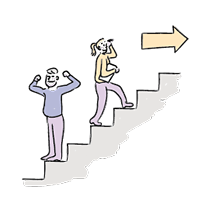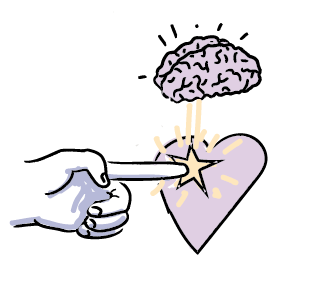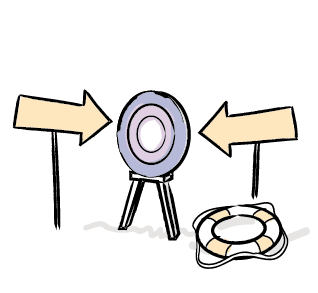FacultyFocus 1-2019


developing motivation for your learners
Why does motivation play a central role in the process of learning and participation? Motivation to learn drives the need to satisfy an individual’s perceived need. A need in this sense is the discrepancy between the current state of knowledge and the preferred future state regarding a subject: “A discrepancy is an inconsistency between ‘what is’ and ‘what ought to be’.” (Fox and Miner, 1999).
10 tips on
“Motivation is the translation of a person’s basic psychological needs and drives, filtered through their view of the world, toward an action with an anticipated result.”
In any teaching role, understanding and effectively intervening in the realm of a learner’s motivation are important skills needed to effectively facilitate learning and changes in clinical practice because, depending on the level of motivation, it can be predicted not only what one learns but also how. Some strategies to increase learner motivation are:
 1. Adult learners are responsible for their own educational paths and life-long learning: encourage autonomous and self-directed learning (Knowles, 1978).
1. Adult learners are responsible for their own educational paths and life-long learning: encourage autonomous and self-directed learning (Knowles, 1978).
 2. Consider the perception of the level of knowledge the learners have of themselves as this will influence their learning
2. Consider the perception of the level of knowledge the learners have of themselves as this will influence their learning
 3. Stimulate intrinsic motivation to learn promoted by the learners drive toward mastery and knowledge.
3. Stimulate intrinsic motivation to learn promoted by the learners drive toward mastery and knowledge.
 4. Manage the “gap”/manage the discrepancy:
4. Manage the “gap”/manage the discrepancy:
- Small gap = low level of motivation (as low levels of anxiety can easily be tolerated)
- Large gaps = low level motivation (as levels of anxiety are high)
In AO, the interpretation of gap scores is as follows:
- < 1: low motivation to learn
- 1 to 2.5: good motivation to learn
- > 2.5: may mean learners are anxious

5. Strategize enhancing motivation to change the status of the learner’s perception: learners must be able to identify standards for outcomes, performance, and competency and perceive them as valuable and desirable in their own practice (Fox and Miner, 1999):
- Encourage accurate self-assessment of current patient outcomes, performance, and competency
- Peer observation
 6. Ensure adherence to the AOs 7 Principles of Quality Education:
6. Ensure adherence to the AOs 7 Principles of Quality Education:
- Interactive
- Promotes feedback
- Leads to verifiable outcomes
- Motivates to learn
- Based on needs
- Relevant
- Promotes reflection
 7. Use the Burch model to motivate your learners to learn and influence their consciousness (awareness) and skills levels (competence) moving your learners through the following levels:
7. Use the Burch model to motivate your learners to learn and influence their consciousness (awareness) and skills levels (competence) moving your learners through the following levels:
- Unconsciously unskilled―we don’t know that we don’t have this skill, or that we need to learn it
- Consciously unskilled―we know that we don’t have this skill
- Consciously skilled―we know that we have this skill
- Unconsciously skilled―we don’t know that we have this skill (it just seems easy)
 8. Ensure diversity in your teaching body; act as a role model and lead by example motivating your learners to do the same; use inclusive language; be culturally sensitive.
8. Ensure diversity in your teaching body; act as a role model and lead by example motivating your learners to do the same; use inclusive language; be culturally sensitive.
 9. Create a safe and trusting environment; clearly define learning objectives and take-home messages.
9. Create a safe and trusting environment; clearly define learning objectives and take-home messages.
 10. Understand and facilitate learners’ motivations to acquire the skills, knowledge, and attitudes preparing the learner for life-times of learning and providing care to patients.
10. Understand and facilitate learners’ motivations to acquire the skills, knowledge, and attitudes preparing the learner for life-times of learning and providing care to patients.
References
Brissette A, Howes D. Motivation In Medical Education: A Systematic Review. WebmedCentral Medical Education. 2010;1(12):WMC001261.
Burch N. Conscious Competence Ladder. Solana Beach, USA: Gordon Training International; 1970.
Fox RD, Miner C. Motivation and the facilitation of change, learning, and participation in the educational programs for health professionals. J Contin Educ Health Prof. 1999; 19(3):132–141.
Knowles M. The adult learner: A neglected species. 2nd ed. Oxford, UK: Gulf Publishing; 1978.
AO Foundation
FacultyFocus
1-2019
AO Foundation
Copyright © 2019 AO Foundation.
All rights reserved.